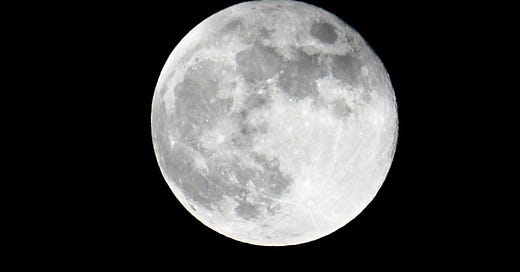Crypto Collapse | Go Artemis, Go | Social Media Rethink
Written while taking a break from Twitter drama
I missed the lunar eclipse but did get this (Credit: Lance Ulanoff)
Eeeeh, I don’t think so
Perhaps you remember the Super Bowl commercial with Larry David. He was pitching FTX, a cryptocurrency exchange, in his own inimitable way.
The idea was that David encountered useful innovations throughout history, like the wheel, the fork, coffee, the light bulb, the toilet, and finally FTX, a so-called “easy way to get into crypto.”
In each instance, Larry responds, more or less, with, “Ehhhh, I don’t think so….and I’m never wrong about this stuff. Never.”
This may have been the only thing David was very right about it. FTX, which let people exchange cryptocurrencies for other cryptos and also traditional currency for cryptocurrency suffered a spectacular collapse last week that included bankruptcy and the CEO stepping down.
The thing is, this was triggered by a larger, ongoing crypto malaise, where the value of most cryptos took a tumble over the last six months and seemed to expose vulnerabilities in the crypto and NFT market.
And, like a contagion, I think this is making people rethink associated ideas like Web3, which seeks to decentralize control of the web through a multitude of technologies that includes cryptocurrency and the cryptographic keys we might use to identify ourselves online.
The virus has also infected the Internet and technology’s biggest idea: The Metaverse (you’d probably be spending cryptocurrency and buying NFTs in the Metaverse) after Meta laid off 11,000 employees in part because the company is losing billions on its Metaverse bet.
What is going on here?
Personally, I think we got ahead of ourselves. Remember the initial dotcom boom and irrational exuberance? It was followed by the massive dotcom bust. I was there for it. It was not pretty.
It was also not the end, obviously.
I think the same thing is happening with crypto, NFTs, and even the Metaverse.
There is a place for all these technologies in our future. Crypto, in particular, is a powerful idea. Tokenization of identity and digital objects is an excellent way to prove identity and provenance. We’re far from ready to live and work in the Metaverse, but VR and AR remain important technologies that will power entertainment and gaming for years to come.
In time, the hardware will get more powerful as it gets lighter and cheaper, eventually putting it in the hands of billions of people.
Crypto technology could be what underpins the entire Metaverse economy.
In other words, this crypto winter is simply a season. It’s cold, and dark and will last for a while. Then, a new season will come, and Larry David might be wrong again.
Is it a go?
NASA rolled Artemis 1 launch vehicle back out right before Hurricane Nicole rolled through Florida, but they insist it’s A-OK and will, after multiple glitches and delays, be ready for launch on Nov 16 (at 1:04 AM EST 👀).
While uncrewed, this is a hugely important mission. Artemis is Phase One of the U.S. going back to the Moon. If it does launch on Wednesday, Artemis will head to the moon and send the Orion capsule into lunar orbit and then return.
If all goes well, we could see a crewed mission within two years, and eventually, we could finally set up shop on the moon.
Personally, I’m keeping my fingers crossed. I wonder how long will it be before someone is building a hotel on the Moon?
What were we doing, anyway?
Whatever we’ve gone through with social media over the last almost two decades, it does feel as if we’re all slowly waking up from sort of fever dream. The fortunes of the biggest social media platforms in the world have changed and part of us feels like we’re moving on.
But only part. Facebook and Twitter might be falling out of fashion but there ae still billions of people using them every day. TikTok shows no signs pf slowing down.
Still, reading Ian Bogost’s deep dive, “The Age of Social Media is Ending,” got me thinking about what we have been doing and, despite clear benefits, this might have been a mistake.
Part of Bogost’s argument hinges on the differences between social networks and social media. Twitter and Facebook (and Friendster and Google + before it) started as social networks that tied people together in ways that, with traditional communication networks, was not possible -at least not at scale - before.
Social media is, however, about content. If you’re on social media, you are creating content for an audience of friends, family, and strangers. Not everyone is meant to be a content creator and we’ve seen how, when the demand of constant creation becomes too strong, people break. So, it’s not just about the deleterious effects of social media content on young minds, it’s this 24/7 performative nature of social media participation itself.
I guess the question is, as these things either wind down or pull back, do people start to revert to their former non-creator selves? Do they go back to becoming pure consumers and audiences?
My guess is no. Social media opened a spigot that can’t be turned off. The lure of viral fame (and fortune) - as remote as they may be - is still simply too strong. If Twitter and even Facebook ever go away, a platform like TikTok and whatever follows it will grow and fill the gap.
We don’t get to go back.
That’s all for now. Be sure to follow me on Twitter (while it lasts) and keep tabs on TechRadar where I do the majority of my writing.
Stay well
Be good to each other



